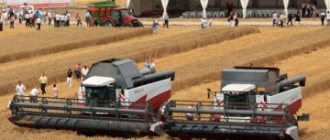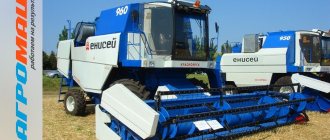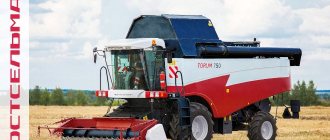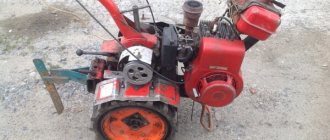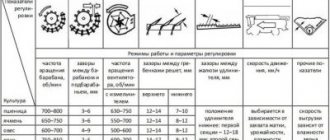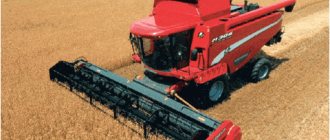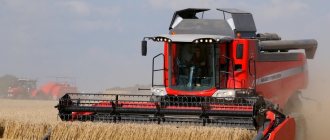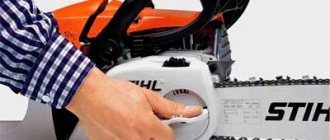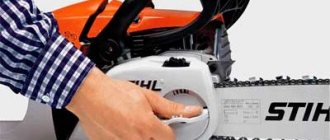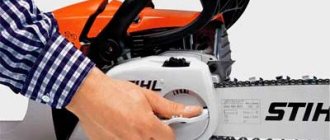Scientific and industrial development of technologies is always dynamic. Despite this, combine harvesters, invented in the United States in the 19th century, still occupy the top position in the ranking of the best agricultural equipment. These mechanized machines replace the work of dozens of people. Thanks to them, grain collection from the fields occurs quickly, in large volumes, without loss of quality. There are many foreign and domestic manufacturers of combine harvesters on the market. This review article will tell you about the leading brands and the most popular brands.
Manufacturers of combine harvesters
A grain harvester is a multi-stage machine for collecting and processing grain. The process of its work is completely mechanized and includes 6 stages of work (work at all stages takes place simultaneously). What does a smart car do?
- Collects (cuts) ears of corn.
- Transfers them to the thresher.
- Threshes grains from spikelets.
- Sorts (hulls) grains, separating them from debris and dry shells.
- Transfers the cleaned grains to the hopper.
- The conveyor belt unloads them from the car.
In order to understand demand and identify the most productive and reliable grain harvesting machines, the industry periodically conducts surveys or organizes marathon competitions. Based on the data in 2003, the top five included the following combines:
Acros
- "Acros" -530/580. Manufacturer: Rostov. The company has 13 branches in 4 countries and has contracts for the purchase of equipment with 56 countries. They produce more than 150 models of equipment, including 8 models of grain harvesters.
- "TORUM"-740-307. Manufacturer: ROSTSELMASH.
TORUM
- "Vector" - produced by ROSTSELMASH.
Vector
- "Claas Tucano", produced at the German Claas plant. This is a huge holding with factories all over the world. There are about 50 dealers in Russia, including a plant in Krasnodar.
Claas Tucano
- “John Deere” STS 9770, the brainchild of the American company Deer&Company, named after its “founder” blacksmith John Deere. The company has existed since 1837, in partnership with Russia since the 20s of the last century. Successful cooperation led to the opening of a plant in the Moscow region.
John Deere
Attention! More than 1,000 farms in the Krasnodar and Stavropol Territories participated in the 2003 survey.
Test results
Upload performance. One of the important indicators for assessing the technical level of a combine is the time spent unloading grain from the bunker, since they change significantly throughout the work shift and, naturally, cause a reduction in the shift productivity of the combine. Practical experience of using Claas Lexion combine harvesters on the fields of an agricultural holding shows that on average one combine threshes 600-800 tons of corn per day, which is approximately 80 units of bunkers. The average time to unload one bin is 4-5 minutes. It is easy to calculate that unloading them when the combine is stopped will take up to 4-6 hours. Therefore, the speed of grain unloading is a significant indicator of a combine harvester. Of course, increasing the productivity of the grain harvesting unit is facilitated by the use of storage hoppers, which allow unloading of the harvested grain on the go. Therefore, the upload speed is also an important parameter. To evaluate the grain unloading system, as part of the experiment, a special experiment was carried out to study and evaluate the progress of the technological operation “unloading grain from the combine bunker,” that is, determining the performance indicators of the grain unloading system and the corresponding time expenditure.
The test results showed that the unloading performance of the Lexion 770 Claas and Tucano 580 Claas is quite high; its performance in both tested combines is close in value (Tucano 580 Claas is inferior in performance by only 10%). And this suggests that in this parameter the Tucano 580, at a lower cost and power, can successfully compete with its “older” colleague.
Optimal cleaning speed. The second test is to determine the optimal harvesting speed while maintaining the acceptable level of losses behind the thresher and reaper.
The first thing that was determined during this test was the potential capabilities of the headers for harvesting corn for grain and the quality of their work (in particular, taking into account grain losses behind it depending on the operating speed). To study this dependence, each of the headers in the unit with the corresponding combine worked in four speed modes (4, 6, 8 and more than 8 km/h). Based on their results, the following was carried out: measurements of the actual operating speed; determination of grain losses behind the header (%). Based on the results obtained, the optimal operating speed of combines was determined, at which the quality of work is ensured - so that losses behind the header do not exceed 0.5%. Summing up the results of the test, we can say that both headers at speeds up to 5 km/h provided an acceptable level of grain losses - 0.1%. And with increasing speed, this figure increased to 0.5%.
Of course, as the speed increased, the losses increased, but did not exceed the level of 0.5% even at speeds close to 10 km/h. Geringhoff Rota-Disc header (with Lexion 770 Claas combine): 11.2 km/h, grain loss - 0.35%. Corn header Corio 870 C (with Tucano 580 Claas combine): 9.3 km/h, loss behind the header - 0.42%.
Both 8-row headers have proven their perfection and ability to effectively provide the MSS of both combines with grain-straw mass of high-yielding varieties of grain corn with a yield of more than 100 c/ha.
Study of the potential functionality of a combine thresher in relation to the quality of work - to make informed decisions on establishing technological regimes for corn threshing during an operational and technological assessment.
The operating speed of the combine in field conditions is the main factor in achieving and ensuring high productivity by the combine at an acceptable level of losses. To determine the potential of both combines in specially prepared areas of the field, a special test was carried out to determine losses behind the thresher, subject to stable operation of the combines at low, medium, high and maximum possible operating speeds: 4, 6, 8 and more than 8 km/h. The optimal values were taken to be that losses behind the combine should not exceed the permissible 2% (0.5% behind the header + 1.5 behind the thresher = 2%). Of course, you can choose other levels of restrictions, but these are the indicators accepted by farmers around the world and are a balance between harvesting speed and the level of acceptable losses.
Depending on the level of provision of the farm with combines, the structure of crops and climatic conditions of harvesting and, accordingly, the predicted harvesting time, each farmer can set his own levels of restrictions: less losses - longer to harvest, but more to harvest; large losses - collect faster and from a larger area. In our opinion, 2% of total losses is the optimum that modern MSS designs of all types of combines should provide today. It remains to determine the optimal operating speed and, accordingly, productivity - in order to further conduct the main performance test. The test results are presented in the table and graphically illustrated in the figure.
Grain losses behind the combine depending on the operating speed. As one might expect, the Lexion 770 combine had lower loss parameters. At the same time, at the start (at a speed of about 5 km/h), the difference between the losses of the two combine harvesters was insignificant: in the Lexion 770 - 0.18%, in the Tucano 580 - 0.25% (that is, the difference was 0.07%) . But with increasing speed, the Lexion two-rotor separating device worked more efficiently. Therefore, the maximum possible speed at which the process can be carried out in the Lexion combine was 11.2 km/h, while in the Tucano it was 9.3 km/h. Thus, the difference between losses reached 0.3%.
In general, the speed of combine harvesters was limited by the power of their engines, and not by the technical capabilities of the threshing and separating system. That is, they simply did not have enough power to pass the threshed mass through themselves. Therefore, in simple terms, the threshing and separating systems of both combines are more likely to clog than to increase the level of losses by more than 1.5-2%. After all, already at speeds of 11.2 and 9.3 km/h we received almost 100% engine load, while losses due to threshing-separating systems and headers were at the level of 1.03 and 1.38% (with the recommended permissible - 1. 5%). Based on the results of testing on the potential throughput of combines, it should be noted that neither Tucano 580 nor Lexion 770, thanks to the perfection and balanced parameters of their threshing and separating systems, exceeded the loss limit we conventionally established even at the highest possible operating speed and with corn yield more than 100 c/ha. Therefore, we decided not to limit operating speeds in the performance test.
The operational and technological assessment of combines takes into account not only the potential capabilities of the header, separating device and unloading system, but also the assessment of the combine as a whole in terms of per-hectare productivity per hour of working time.
To carry out such an assessment, each combine was “provided” with an area that ensures the operation of one machine for about 1.5 hours of basic time and allows us to determine all the elements of time costs characteristic of a work shift. The operating speed of the combines was: Lexion 770 - about 12 km/h; Tucano 580 - 10 km/h. The length of the headland is on average 376 m. The optimal operating speed of each combine was set by representatives of the dealer company, taking into account ensuring work with acceptable quality - so that grain losses behind the unit do not exceed 2% (1.5% - behind the thresher + 0.5% - behind reaper).
During this test, the fuel consumption of each of the combines was also determined. Before the assessment, the fuel tanks of all combines were filled with diesel fuel completely to the control mark on the filler neck. During the test evaluation of combines, heavy-duty bunker-loaders were used, which took grain from the combines upon completion of one technological “circle” (the working stroke of the unit back and forth). Using the same bunkers, grain was weighed, and road transport was used to transport it from the reloading bins to the elevator.
During the experiment, indicators of actual conditions and operating modes were determined: operating speed, grain threshing and yield from this area, the number of grain unloads from the combine bunker. They also periodically and stochastically carried out operational monitoring of the level of losses. In none of the measurements did the total losses during this experiment exceed the permissible level of 2%.
The determination of the structure of time spent on a work shift was carried out on the basis of a study: time spent on the main work, making turns, unloading grain from the combine bunker, waiting for auxiliary transport to unload grain, performing all the work - and taking into account the coefficient of working strokes. According to the results obtained, technological productivity (ha/h), productivity per hour of main time (ha/h; t/h) were determined.
After conducting an operational and technological assessment of the combines, the fuel tanks were refilled with diesel fuel completely up to the control mark on their filler neck. Based on the amount of refueled fuel, the amount actually spent on performing a given amount of work was determined - per ton and per hectare of harvested area. The test results turned out to be quite interesting. Thanks to optimal speed and maneuverability on turns, the Tucano 580 achieved a productivity of 3.2 ha/h, while the Lexion 770 achieved 3.3 ha/h.
In other words, the Tucano 580 practically kept up with its “big brother” Lexion 770. Perhaps it was due to the fact that the Lexion 770 is not new? At the same time, it should be noted that the Tucano 580 “hit” a section of the field with a higher yield, which allowed it to gain more than tons. But in terms of threshing hectares, it was not far behind - by 0.1 hectares, which is very good for a combine of less power, but with powerful equipment. By the way, when determining fuel consumption, a small surprise awaited us: despite the difference in hectare and time consumption indicators, the values of specific fuel consumption (liters per ton of collected products) were identical.
Description of models of the Rostov plant
Let's take a closer look at the technical characteristics of the above and some other models. Akros-580 grain harvester belongs to the “new generation” equipment. With its required large dimensions (length - 8.6 m, width - 3.88 m), the car looks compact and streamlined. Comfortable overview cabin, equipped with 4 German-made hydraulic modules, it includes control for:
- steering;
- reel drive;
- chassis drive;
- main control.
The advantages of the model include the ability to control auxiliary equipment that is connected additionally. The Vector-410 combine harvester is intended for small and medium-sized farms. The seasonal operating time of this machine is about 750 hectares. Size – 7.9 m in length (together with the header – 12 m), width – 3.5 m. One of the important characteristics of the combine harvester is an additional function. The Vector can form straw into compact bales and lay them out neatly as you go.
Don 1500
"Don 1500" is a Soviet combine harvester, the predecessor of more modern machines. Until the early 2000s, for 20 years it was the most popular grain harvesting unit. The designation “1500” indicates the width of the threshing drum. The equipment scheme is classic:
- threshing device;
- drum - 1 piece;
- keyboard straw walker;
- grain bin with a volume of 6 m³;
- engine - 235 hp
A chopper, spreader, and stacker are additionally connected to the combine.
Operation and Maintenance
The machine is operated in accordance with the instructions, and maintenance is carried out in accordance with the established regulations.
The corn cleaner must be in good condition during its service life. Operating the machine without maintenance is not allowed.
Before work, the header is prepared for assembly and work with the combine. To do this, it is installed on a flat area, attached and pulled in with tightening hooks. Then a run-in is carried out and the heating of the bearings and gearboxes and the tightening of fasteners are checked. The duration of the process is at least 1 hour.
When connecting for the first time, adjust the gap between the hook and the locking rod and adjust the angle of inclination of the cutting knife relative to the ground.
Models from other manufacturers in Russia and Belarus
The grain harvester "Yenisei"-1200 has been produced by the Krasnoyarsk plant since 1985. Having large dimensions, the machine is designed to work on large fields. The model has modifications: “Yenisei”-1200 and “Yenisei”-1200M. Unlike their predecessor, they are equipped with one drum instead of two and can work in fields with high humidity levels. Size: 10.5 m long and 3.8 m wide. Productivity - 9 thousand kg/h. The volume of the grain tank is 4.5 thousand liters. “Yenisei” has the best maneuverability among its “brothers” thanks to the hydrostatic transmission drive. The combine runs smoothly and the controls are highly precise.
Yenisei
Kolos combine harvester is a model of equipment from the 70s of the last century. Designed for harvesting grains and legumes. Equipped with a front header and a two-section grain bunker. The last indicator speaks in favor of this model. One of the disadvantages of the car is the location of the cabin. It is located on the same unit as the thresher and has a low visibility, especially when moving backwards. The main advantage is endurance and long service life, about 60 years.
Polesie cars are manufactured in Gomel. This modern equipment is characterized by high performance, compact dimensions, easy running, and is equipped with a comfortable cabin. Engine power - 210 hp, threshing - two-drum. “Polesie” does not lose high performance under difficult working conditions - pollution, large amounts of straw, excessive humidity.
Polesie
New giant combine harvester New Holland CR10.90
The newest New Holland CR10.90 grain harvester rightfully deserves to be called “Big Daddy”, as today it occupies a leading position in the world of agricultural machinery. The Cursor 16 engine, running on diesel fuel, has a sixteen-liter capacity and provides the combine with 652 horsepower. This is enough to keep all the combine units in working order and enough to move the machine loaded with grain. It is located in a huge bunker, the volume of which is 14,500 liters.
Characteristics of the New Holland CR10.90 combine harvester:
- This is quite a heavy and impressively sized piece of equipment.
- The machine is capable of moving not only on a flat field, but also on adjacent territories that do not have a very flat surface. To achieve this, engineers equipped the combine with front-wheel drive and SmartTrax flexible tracks.
- In the front-wheel drive, engineers implemented the Terraglide intelligent suspension system, which allows the tracks to smoothly bend around uneven surfaces.
Moreover, the weight of the machine will be evenly distributed over the largest possible area, thereby increasing the overall maneuverability of the combine.
Models of foreign factories
John Deere combine is one of the most popular in the world. The advantage of using it is a harmonious combination of price and quality. Maximum reliability and ease of operation. Combines of this brand are used in fields with a large volume of work, including on inclined surfaces. A powerful engine (305 hp) of its own brand and a well-functioning mechanism of hydraulic and electrical systems allow it to work even in rain. Dimensions of the combine: 8.98 m long, 3.77 m wide. Advantages include the presence of:
- “catcher” of stones;
- cleaner;
- accelerator device for feeding cut raw materials.
John Deere
Combine "Claas Tucano-450" is a representative of the premium class. The machine is equipped with a multifunctional pipeline connection system and a central lock. The header is equipped with a control unit with memory of previously set modes. Inside there is a powerful and reliable Mercedes-Benz engine and a large fuel tank (650 l). This allows uninterrupted operation in remote fields.
Attention! The successes of Claas combine harvesters are included in the Guinness Book of Records.
Design and principle of operation
The operating principle of the corn harvester is simple. The auger mechanism grabs the stems of the plant, lifts them and pulls them down. Tear-off plates separate the cobs and send them to the threshing apparatus. In a chopping system consisting of knives and blades on horizontal rollers, the stems and leaves are crushed and scattered across the field.
Harvesting grain, cutting and chopping the plant occur simultaneously.
The chopper operates at a minimum distance from the soil surface, captures all fallen crops and removes weeds. Management and control of the operation is carried out from the operator’s cabin.
The design of the header includes the following main components:
- frame;
- reel;
- conveyor;
- chopper;
- screw.
Many modules are equipped with special casings to protect working parts from mechanical influences. The linkage mechanism allows the devices to be aggregated with any combines of domestic and foreign production.
Mini harvesters
Managers of small farms, along with large producers, need the mechanization of manual labor. In recent years, small-sized machines for agricultural work have been in great demand. These include mini harvesters. Why are they attractive for a novice farmer or manager of a small farm? This:
- Small dimensions providing maneuverability in a small space. Does not require a large area for settling.
- Affordable price.
- They perform the same list of works as their larger “brothers”.
By replacing three types of equipment at once: a thresher, a winnower, a reaper, a mini-harvester significantly reduces the work process from cutting the ears to storing the finished product. In addition, many modern models are equipped with additional equipment if desired. It expands the “responsibilities” of the mini harvester. For example, you can sow, knit sheaves from straw.
In general, the appearance of mini harvesters is a smaller copy of their “big brothers”. Many models have operator cabins, several speed gears, and additional levers. In particular, the lever for adjusting the height of the ears. This is true for areas with uneven terrain. Mini combine harvester options are presented by almost all well-known harvesting machine factories. Main popular models: Zarya, John Deere, Claas, Farmer.
Currently, the agricultural machinery market is replete with offers. A farmer belonging to any segment: large or medium-sized farm or small farm can easily find a combine harvester suitable for his capacity and financial capabilities. The main thing is to study in detail the technical characteristics of the equipment, the nuances of maintenance and clearly outline the list of necessary work.

